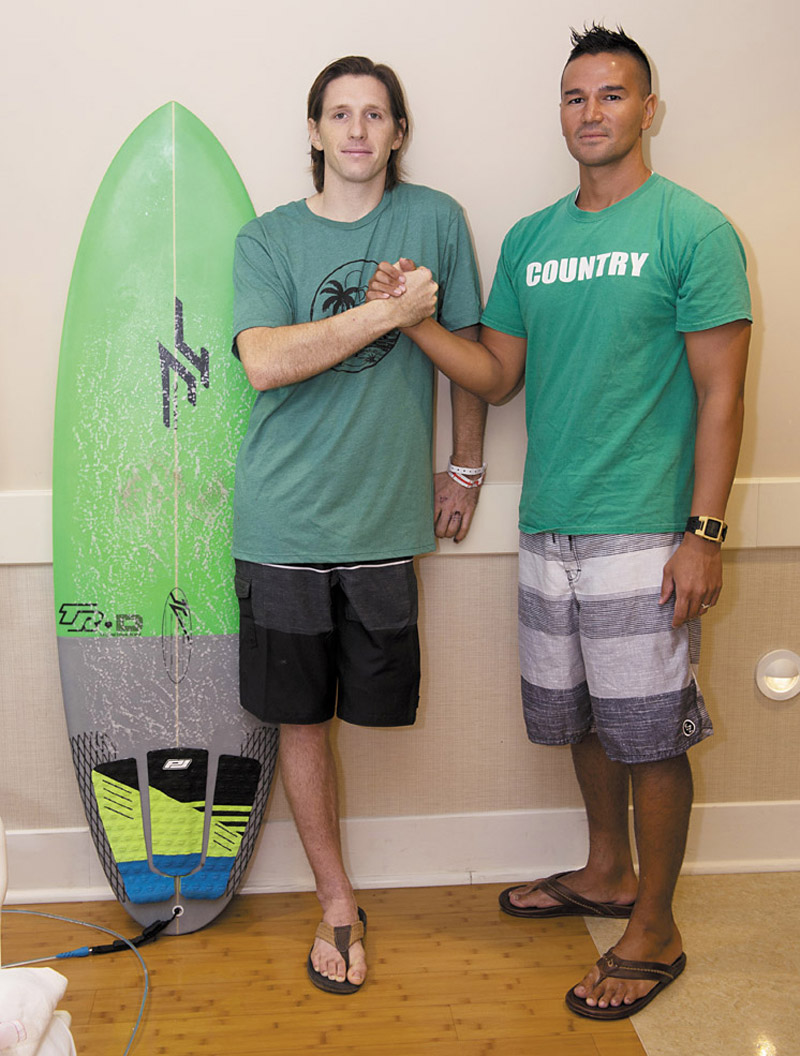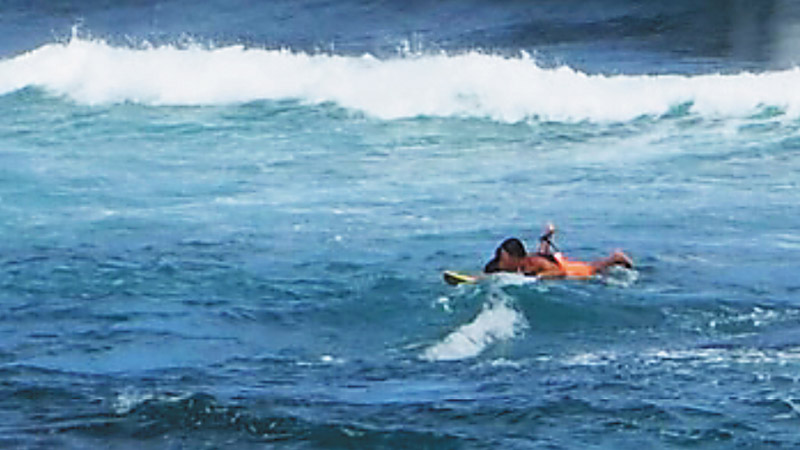Blood Brothers

They’d never met until Oct. 9, when Colin Cook was attacked by a tiger shark off Oahu’s North Shore and Keoni Bowthorpe came to his rescue. Now they are forever bonded. PHOTO BY NATHALIE WALKER
A week after Colin Cook’s encounter with a 13-foot tiger shark, his dad Glenn, who lives in Rhode Island, is matter-of-fact as he recounts Colin’s ordeal. Until he gets to the fateful call:
“Listen, your son was attacked by a shark.”
Dad wipes tears from his cheeks as he describes falling to his knees, and then receiving a second call. It was Colin in the back of an ambulance, borrowing the EMT’s phone.
“Dad, don’t worry. I’m all right.”
When Colin and hero-friend Keoni Bowthorpe start sharing their story — one fighting off the shark, the other coming to his rescue — they sound like, well, two young surfers with the gnarliest of stories. They even manage to joke and laugh.
Since the attack, plenty of aloha has gone out to Cook. Fellow surfer and shark-attack victim Mike Coots, who now surfs with a prosthetic leg, contacted him. And our own Bethany Hamilton, along with 20 or so other women who have lost a limb (she was guiding them on an inspirational surf retreat at the time of Cook’s attack), reached out to him with a care package and letters of encouragement.
“The outpouring from the (Hawaii) community is like nothing I’ve been part of,” says Dad. “The culture here, we’re so appreciative.”
Yet, Colin is aware the challenge has only just begun. He says it’s that initial wave of support from everyone that has given him the motivation to get through these first grueling days as he recovers and begins rehabilitation, learning to maneuver in a new way.
“My body still feels the same, but I have to remember my limitations and how I only have one leg. It’s like I want to go surf right now, but I can’t.

Just after the attack, Bowthorpe, with Cook on his board, paddles for shore as the shark thrashes in the water (whitewater in foreground) while circling them
PHOTO COURTESY OF THE COOK FAMILY
Even as a youngster in Rhode Island, Cook was an extreme sports junkie — skateboarding, snowboarding, and riding dirt bikes and motocross. He dabbled in surfing too, and by 16 it had become his life’s passion. Five years later, he moved to Oahu, where he began living on the North Shore, surfing daily at nearby Leftovers Beach just outside of Haleiwa, and exploring all aspects of surfboard-building. Now 25, and with plenty experience under his belt, Cook had just begun his own business shaping boards, including the green board he was using Oct. 9, when his life would change forever.
The way he and Bowthorpe tell it, times when friends are all out surfing together are as common as times when a solo surfer goes out, unable to resist the call of waves. On this day, there were at least two young men who didn’t really know each other. Bowthorpe, 33, done with his morning session, had turned his stand-up paddleboard toward shore. Cook was watching the horizon for some waves.
“Next thing I know, something is on me,” says Cook. “It took me fully off the board and I was underwater. You’re moving so fast, you don’t know what’s going on. I opened my eyes, the water was clear. I felt nothing. My body was numb.”
But the fight for his life had begun.
Bowthorpe, who was about 150 yards away, thought he heard Cook call out to him.
“So I turned around and saw the shark hit him. I saw it drag him down. Then he was calling for help and I went straight back over.”
Bowthorpe tries to deflect the shark with his paddle as Cook jumps onto the back of the board. A harrowing journey to shore follows: The two chugging along seemingly forever on a submerged board meant for one passenger, contending with 6-foot wave-face sets and an aggressive shark that continues after them. Cook begins reciting his final words to Bowthorpe, a goodbye to his parents. But Bowthorpe yells at him, refusing to accept Cook’s message of defeat. Passing in and out of consciousness, Cook manages to hold onto the board, mangled hands and all. Once on shore, friends and strangers rush to help, applying a tour-niquet made from a surfboard leash to the severed leg.
At Queen’s Medical Center, Cook requires several blood transfusions, four hours of surgery, and 30 inches of stitches on his wounded hands (including a partially severed finger) that repeatedly punched that massive head of teeth and muscle as it took his left leg.
“But he’s alive,” says mom Mary Beth.
Cook smiles and points a confident finger heavenward as he thinks of the dominoes of fortunate occurrences that saved his life. For one, Bowthorpe was the right guy in the right place. For the past few months, Bowthorpe has been filming a documentary, Saving Jaws, and he attributes knowledge he gleaned from shark experts to helping save Cook’s life.
“The main place (we’ll feature) is Hawaii,” says Bowthorpe, “focusing on sharks and the long history of culture we have here, and on Native Hawaiians and their relationship with sharks as something to be revered. We love the ocean and they’re part of it, so we’ve got to have respect.”
“It’s their home, not ours,” agrees Cook.
UH professor of religion Marie Alohalani Brown, who does research in Hawaiian language and is herself Hawaiian and a cultural practitioner, describes the traditional relationship between Hawaiians and their environment as one of respect. Island legends are rife with stories of shark gods and guardian ancestors, or ‘aumakua, who take the form of a shark. Brown also mentions having read instances of ali‘i sport-fishing great whites. More recently, Hawaiian-language newspapers from the 19th and 20th centuries portray a sort of customary acceptance that man and aquatic creatures shared with one another.
“On Nov. 20, 1861, when a shark attacked two boys who were surfing offshore of Lahaina, Maui, they showed no fear at all,” says Brown, translating from the original paper. “According to the article, one boy shoved his surfboard into the shark’s mouth, and then both boys shoved their hands into the shark’s gills and hung onto it until it neared the shore. An article published Dec. 13, 1907, reports in the last few weeks an unusual number of sharks had been seen in the bay and offshore of Alakea Street in Honolulu, but that neither the sharks nor the swimmers seemed afraid of each other.”
However, in the 1960s and ’70s, fear of sharks led to systematic culling in Hawaiian waters. But with tigers being killed off, smaller shark breeds began multiplying, creating visible changes in the ocean ecosystem. A pervasive understanding now exists that tigers are a necessary part of our environment, and perhaps if there’s a silver lining to the culling, it’s that researchers have learned so much about the creatures. (Now, research involves tagging the sharks. To view their tracked movement, visit oos.soest.hawaii.edu/pacioos/projects/sharks.)
Tiger sharks can grow up to 15 feet, making them the “largest and most aggressive shark we have in our Hawaiian waters,” says recently retired John Naughton, a longtime marine biologist with NOAA and member of the tiger shark control studies all those years ago. We do have great whites in open ocean, but the tigers are the most dangerous of the near-shore species. They feed particularly on green sea turtles and other large aquatics, like dolphins and other sharks, so when they prey on humans, it’s usually a case of mistaken identity.
“They’re big and they weigh hundreds of pounds,” adds Naughton. “A lot of sharks have triangular teeth that take large chunks out. The tiger shark hits, and then with these serrated, angular teeth, it just shakes its head. It’s got really massive muscles on its head and it shakes the head back and forth, and can easily cut off huge chunks of meat and go through bone.”
He points out that tigers serve an important purpose by keeping other shark populations in control, but also by cleaning the ocean — whether it’s a dead whale or another decaying, sick or injured animal that comes floating by.
“One really big tiger shark we caught had a big bulge in its stomach,” Naughton says.
“We’d shoot them and boom them up on deck, and when we cut it open, it had a complete horse’s head in its stomach.”
Tigers take advantage of opportune meals at river mouths, where wild pigs or goats washed downstream in the rain or carrion tossed into the water by farmers comes flowing downstream.
“They get a little more food around river mouths when they flow faster in storm conditions,” says Naughton. “We know from studies, in other parts of the world too, that tiger sharks are successful at coming into shore in brown water and ambushing prey because they can look up and catch them silhouetted against the surface.”
He urges swimmers to stay away from brown waters and from nighttime swimming, when sharks are more likely to feed closer to shore.
“The upshot is people should recreate in the ocean,” says Naughton. “Don’t let the occasional shark attack keep you out. It is a very unusual event.”
But never swim alone, he adds. Most survivors had someone nearby who helped them to safety.
And fighting works. Cook fought back, as did Oct. 17 Lanikai attack victim Tony Lee, who reportedly reached into the animal’s eye socket and ripped out its eyeball.
Cook has every plan to use gofundme donations that came in from around the world toward a customized prosthetic, and to get back on his now-iconic green board and return to Leftovers as soon as possible.
“It’s always going to be in the back of your head when you go back out there, but at the end of the day, surfing is my life and passion,” he says, “so I’m just going to get back out no matter what, even if the fear is there.
“I’ll think twice about going out alone.”
It’ll be six months or so before Cook can get back in the waves, but the day he does, says Bowthorpe, the surfers who frequent Leftovers all will be there to join him.




